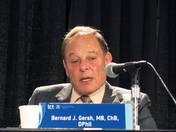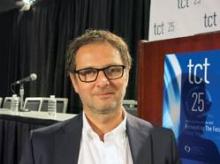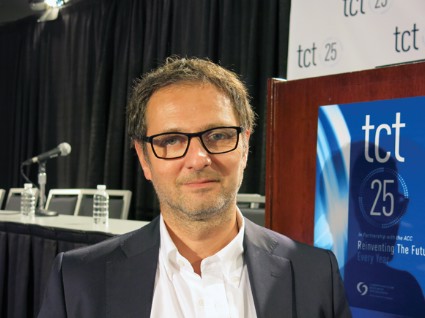User login
SAN FRANCISCO – Giving bivalirudin in the ambulance to patients with ST-segment elevation MI before primary percutaneous coronary intervention significantly improved 30-day bleeding outcomes in a randomized controlled trial in 2,218 patients, compared with giving unfractionated or low-molecular-weight heparin and optional glycoprotein IIb/IIIa inhibitors.
The bivalirudin group showed nearly a 40% decrease in the primary outcome, a composite of death or major bleeding not associated with coronary artery bypass grafting (CABG), compared with the control group. Rates for the primary outcome were 5.1% in the bivalirudin group and 8.4% in the control group at 30 days, Dr. Philippe Gabriel Steg and his associates reported at the Transcatheter Cardiovascular Therapeutics annual meeting.
The 30-day rate of acute stent thrombosis, however, was approximately sixfold higher in the bivalirudin group (1.1%) than in the control group (0.2%) in the EUROMAX (European Ambulance Acute Coronary Syndrome Angiography) trial. That did not translate into an increased risk of infarction, which was similar in the bivalirudin group (1.7%) and the control group (0.9%), Dr. Steg and his colleagues said.
The rates of the main secondary outcome – a composite of death, reinfarction, or non-CABG major bleeding at 30 days – also were significantly lower in the bivalirudin group (6.7%) than in the control group (9.1%), said Dr. Steg, professor of cardiology at Université Paris-Diderot and director of the coronary care unit at Hôpital Bichat, Paris.
The study was published online simultaneously with the presentation (N. Engl. J. Med. 2013 Oct. 30 [doi: 10.1056/NEJMoa1311096]).
The benefit from bivalirudin came mainly from reduced bleeding, not reduced mortality. The risk of major bleeding not associated with CABG was 2.7% in the bivalirudin group and 6.1% in the control group, a significant 57% reduction.
Rates of cardiac or noncardiac death at 30 days did not differ significantly between groups, with cardiac death in 2.4% with bivalirudin and 3% in the control group, and noncardiac death in 0.5% and 0.1%, respectively.
The study was underpowered to assess mortality, Dr. Steg said in an interview. He hopes to assess mortality risk at 1 year by analyzing combined data from EUROMAX and a previous major trial that showed bivalirudin’s utility before percutaneous coronary intervention, the HORIZONS-AMI (Harmonizing Outcomes with Revascularization and Stents in Acute Myocardial Infarction) trial (N. Engl. J. Med. 2008;358:2218-30).
Dr. Steg and his associates conducted the EUROMAX study to see if these benefits were still true in the modern era of prehospital treatment and evolving use of glycoprotein IIb/IIIa inhibitors, platelet P2Y12 receptor inhibitors, and radial access for PCI.
The EUROMAX findings were consistent across subgroups of patients, including subgroups defined by PCI access site or by the choice of P2Y12 inhibitor, Dr. Steg reported at the meeting, cosponsored by the American College of Cardiology.
He believes the findings will change practices and convince emergency crews to choose bivalirudin in Europe, where anticoagulation commonly is started in ambulances before arrival at the hospital, a practice that has not yet caught on in most of the United States.
Dr. Gregg W. Stone, primary investigator of the HORIZONS-AMI trial and a discussant of EUROMAX at the meeting, put together a preliminary meta-analysis of the two studies, he reported. Preliminary results suggest significant benefits from bivalirudin in 30-day rates of major bleeding, transfusion, thrombocytopenia, mortality, and subacute stent thrombosis, with a roughly fivefold increase in the risk of acute stent thrombosis. Studies are warranted to determine whether antiplatelet therapy with cangrelor might be a solution to the acute thrombosis risk, said Dr. Stone, professor of medicine and director of cardiovascular research and education at Columbia University, New York.
Dr. Steg received fees from The Medicines Company, which sponsored the study and markets bivalirudin, and he reported financial associations with 16 other companies. Four of his colleagues in the study were employees of The Medicines Company, and 12 other colleagues reported financial associations with that company and/or multiple other companies. Dr. Stone reported financial associations with Boston Scientific, Eli Lilly, and other companies.
sboschert@frontlinemedcom.com
On Twitter @sherryboschert

|
Sherry Boschert/IMNG Medical Media
|
This is an important trial that will change clinical practice, Dr. Bernard J. Gersh said in a panel discussion at a press briefing.
Dr. James B. Hermiller Jr. cautioned that it remains to be seen how the large difference between groups in major bleeding events translates into mortality over time.
Dr. Philippe Généreux said the results especially are important for a vast country like Canada, where transport to PCI often takes 45-60 minutes.
Asked what changes could get the United States to adopt prehospital initiation of anticoagulation, as is common in Europe, none of the panelists had a solution.

|
Sherry Boschert/IMNG Medical Media
|
"We have a different competitive system" in Canada, said Dr. Généreux of New York–Presbyterian Hospital and Hôpital Sacré Coeur, Montreal. "I’ve never seen anything that suggests that prehospital administration and diagnosis are not beneficial, but how we are going to achieve that in the United States, I don’t know."
"It’s difficult to just get ECGs in the field, let alone administer anticoagulants, but we need to get there because this is very important," said Dr. Hermiller of St. Vincent Heart Center of Indiana, Indianapolis.
Dr. Gersh, professor of medicine at the Mayo Clinic, Rochester, Minn., said that it’s possible to change systemic practices in a regional system such as his that spans rural areas, but it’s much more difficult in big cities with multiple competing medical systems.

|
Sherry Boschert/IMNG Medical Media
|
"I think there are real benefits to a national health care system as opposed to pure and simple competition. With a national or even a regional health care system, you can develop protocols and mandate them. This is what’s happened in many countries in Europe," he said. "Our current system, where you may have a city of a million people and four hospitals competing and four different ambulance systems, is not conducive to this. Unless people are prepared to sit down and say, ‘We’ll share the burden,’ I don’t have any idea" how the U.S. system will change.
Dr. Généreux reported financial associations with Cardiovascular Systems Inc. and Abbott Vascular. Dr. Gersh reported financial associations with Pharmaceutical Product Development, InspireMD, and multiple other companies.

|
Sherry Boschert/IMNG Medical Media
|
This is an important trial that will change clinical practice, Dr. Bernard J. Gersh said in a panel discussion at a press briefing.
Dr. James B. Hermiller Jr. cautioned that it remains to be seen how the large difference between groups in major bleeding events translates into mortality over time.
Dr. Philippe Généreux said the results especially are important for a vast country like Canada, where transport to PCI often takes 45-60 minutes.
Asked what changes could get the United States to adopt prehospital initiation of anticoagulation, as is common in Europe, none of the panelists had a solution.

|
Sherry Boschert/IMNG Medical Media
|
"We have a different competitive system" in Canada, said Dr. Généreux of New York–Presbyterian Hospital and Hôpital Sacré Coeur, Montreal. "I’ve never seen anything that suggests that prehospital administration and diagnosis are not beneficial, but how we are going to achieve that in the United States, I don’t know."
"It’s difficult to just get ECGs in the field, let alone administer anticoagulants, but we need to get there because this is very important," said Dr. Hermiller of St. Vincent Heart Center of Indiana, Indianapolis.
Dr. Gersh, professor of medicine at the Mayo Clinic, Rochester, Minn., said that it’s possible to change systemic practices in a regional system such as his that spans rural areas, but it’s much more difficult in big cities with multiple competing medical systems.

|
Sherry Boschert/IMNG Medical Media
|
"I think there are real benefits to a national health care system as opposed to pure and simple competition. With a national or even a regional health care system, you can develop protocols and mandate them. This is what’s happened in many countries in Europe," he said. "Our current system, where you may have a city of a million people and four hospitals competing and four different ambulance systems, is not conducive to this. Unless people are prepared to sit down and say, ‘We’ll share the burden,’ I don’t have any idea" how the U.S. system will change.
Dr. Généreux reported financial associations with Cardiovascular Systems Inc. and Abbott Vascular. Dr. Gersh reported financial associations with Pharmaceutical Product Development, InspireMD, and multiple other companies.

|
Sherry Boschert/IMNG Medical Media
|
This is an important trial that will change clinical practice, Dr. Bernard J. Gersh said in a panel discussion at a press briefing.
Dr. James B. Hermiller Jr. cautioned that it remains to be seen how the large difference between groups in major bleeding events translates into mortality over time.
Dr. Philippe Généreux said the results especially are important for a vast country like Canada, where transport to PCI often takes 45-60 minutes.
Asked what changes could get the United States to adopt prehospital initiation of anticoagulation, as is common in Europe, none of the panelists had a solution.

|
Sherry Boschert/IMNG Medical Media
|
"We have a different competitive system" in Canada, said Dr. Généreux of New York–Presbyterian Hospital and Hôpital Sacré Coeur, Montreal. "I’ve never seen anything that suggests that prehospital administration and diagnosis are not beneficial, but how we are going to achieve that in the United States, I don’t know."
"It’s difficult to just get ECGs in the field, let alone administer anticoagulants, but we need to get there because this is very important," said Dr. Hermiller of St. Vincent Heart Center of Indiana, Indianapolis.
Dr. Gersh, professor of medicine at the Mayo Clinic, Rochester, Minn., said that it’s possible to change systemic practices in a regional system such as his that spans rural areas, but it’s much more difficult in big cities with multiple competing medical systems.

|
Sherry Boschert/IMNG Medical Media
|
"I think there are real benefits to a national health care system as opposed to pure and simple competition. With a national or even a regional health care system, you can develop protocols and mandate them. This is what’s happened in many countries in Europe," he said. "Our current system, where you may have a city of a million people and four hospitals competing and four different ambulance systems, is not conducive to this. Unless people are prepared to sit down and say, ‘We’ll share the burden,’ I don’t have any idea" how the U.S. system will change.
Dr. Généreux reported financial associations with Cardiovascular Systems Inc. and Abbott Vascular. Dr. Gersh reported financial associations with Pharmaceutical Product Development, InspireMD, and multiple other companies.
SAN FRANCISCO – Giving bivalirudin in the ambulance to patients with ST-segment elevation MI before primary percutaneous coronary intervention significantly improved 30-day bleeding outcomes in a randomized controlled trial in 2,218 patients, compared with giving unfractionated or low-molecular-weight heparin and optional glycoprotein IIb/IIIa inhibitors.
The bivalirudin group showed nearly a 40% decrease in the primary outcome, a composite of death or major bleeding not associated with coronary artery bypass grafting (CABG), compared with the control group. Rates for the primary outcome were 5.1% in the bivalirudin group and 8.4% in the control group at 30 days, Dr. Philippe Gabriel Steg and his associates reported at the Transcatheter Cardiovascular Therapeutics annual meeting.
The 30-day rate of acute stent thrombosis, however, was approximately sixfold higher in the bivalirudin group (1.1%) than in the control group (0.2%) in the EUROMAX (European Ambulance Acute Coronary Syndrome Angiography) trial. That did not translate into an increased risk of infarction, which was similar in the bivalirudin group (1.7%) and the control group (0.9%), Dr. Steg and his colleagues said.
The rates of the main secondary outcome – a composite of death, reinfarction, or non-CABG major bleeding at 30 days – also were significantly lower in the bivalirudin group (6.7%) than in the control group (9.1%), said Dr. Steg, professor of cardiology at Université Paris-Diderot and director of the coronary care unit at Hôpital Bichat, Paris.
The study was published online simultaneously with the presentation (N. Engl. J. Med. 2013 Oct. 30 [doi: 10.1056/NEJMoa1311096]).
The benefit from bivalirudin came mainly from reduced bleeding, not reduced mortality. The risk of major bleeding not associated with CABG was 2.7% in the bivalirudin group and 6.1% in the control group, a significant 57% reduction.
Rates of cardiac or noncardiac death at 30 days did not differ significantly between groups, with cardiac death in 2.4% with bivalirudin and 3% in the control group, and noncardiac death in 0.5% and 0.1%, respectively.
The study was underpowered to assess mortality, Dr. Steg said in an interview. He hopes to assess mortality risk at 1 year by analyzing combined data from EUROMAX and a previous major trial that showed bivalirudin’s utility before percutaneous coronary intervention, the HORIZONS-AMI (Harmonizing Outcomes with Revascularization and Stents in Acute Myocardial Infarction) trial (N. Engl. J. Med. 2008;358:2218-30).
Dr. Steg and his associates conducted the EUROMAX study to see if these benefits were still true in the modern era of prehospital treatment and evolving use of glycoprotein IIb/IIIa inhibitors, platelet P2Y12 receptor inhibitors, and radial access for PCI.
The EUROMAX findings were consistent across subgroups of patients, including subgroups defined by PCI access site or by the choice of P2Y12 inhibitor, Dr. Steg reported at the meeting, cosponsored by the American College of Cardiology.
He believes the findings will change practices and convince emergency crews to choose bivalirudin in Europe, where anticoagulation commonly is started in ambulances before arrival at the hospital, a practice that has not yet caught on in most of the United States.
Dr. Gregg W. Stone, primary investigator of the HORIZONS-AMI trial and a discussant of EUROMAX at the meeting, put together a preliminary meta-analysis of the two studies, he reported. Preliminary results suggest significant benefits from bivalirudin in 30-day rates of major bleeding, transfusion, thrombocytopenia, mortality, and subacute stent thrombosis, with a roughly fivefold increase in the risk of acute stent thrombosis. Studies are warranted to determine whether antiplatelet therapy with cangrelor might be a solution to the acute thrombosis risk, said Dr. Stone, professor of medicine and director of cardiovascular research and education at Columbia University, New York.
Dr. Steg received fees from The Medicines Company, which sponsored the study and markets bivalirudin, and he reported financial associations with 16 other companies. Four of his colleagues in the study were employees of The Medicines Company, and 12 other colleagues reported financial associations with that company and/or multiple other companies. Dr. Stone reported financial associations with Boston Scientific, Eli Lilly, and other companies.
sboschert@frontlinemedcom.com
On Twitter @sherryboschert
SAN FRANCISCO – Giving bivalirudin in the ambulance to patients with ST-segment elevation MI before primary percutaneous coronary intervention significantly improved 30-day bleeding outcomes in a randomized controlled trial in 2,218 patients, compared with giving unfractionated or low-molecular-weight heparin and optional glycoprotein IIb/IIIa inhibitors.
The bivalirudin group showed nearly a 40% decrease in the primary outcome, a composite of death or major bleeding not associated with coronary artery bypass grafting (CABG), compared with the control group. Rates for the primary outcome were 5.1% in the bivalirudin group and 8.4% in the control group at 30 days, Dr. Philippe Gabriel Steg and his associates reported at the Transcatheter Cardiovascular Therapeutics annual meeting.
The 30-day rate of acute stent thrombosis, however, was approximately sixfold higher in the bivalirudin group (1.1%) than in the control group (0.2%) in the EUROMAX (European Ambulance Acute Coronary Syndrome Angiography) trial. That did not translate into an increased risk of infarction, which was similar in the bivalirudin group (1.7%) and the control group (0.9%), Dr. Steg and his colleagues said.
The rates of the main secondary outcome – a composite of death, reinfarction, or non-CABG major bleeding at 30 days – also were significantly lower in the bivalirudin group (6.7%) than in the control group (9.1%), said Dr. Steg, professor of cardiology at Université Paris-Diderot and director of the coronary care unit at Hôpital Bichat, Paris.
The study was published online simultaneously with the presentation (N. Engl. J. Med. 2013 Oct. 30 [doi: 10.1056/NEJMoa1311096]).
The benefit from bivalirudin came mainly from reduced bleeding, not reduced mortality. The risk of major bleeding not associated with CABG was 2.7% in the bivalirudin group and 6.1% in the control group, a significant 57% reduction.
Rates of cardiac or noncardiac death at 30 days did not differ significantly between groups, with cardiac death in 2.4% with bivalirudin and 3% in the control group, and noncardiac death in 0.5% and 0.1%, respectively.
The study was underpowered to assess mortality, Dr. Steg said in an interview. He hopes to assess mortality risk at 1 year by analyzing combined data from EUROMAX and a previous major trial that showed bivalirudin’s utility before percutaneous coronary intervention, the HORIZONS-AMI (Harmonizing Outcomes with Revascularization and Stents in Acute Myocardial Infarction) trial (N. Engl. J. Med. 2008;358:2218-30).
Dr. Steg and his associates conducted the EUROMAX study to see if these benefits were still true in the modern era of prehospital treatment and evolving use of glycoprotein IIb/IIIa inhibitors, platelet P2Y12 receptor inhibitors, and radial access for PCI.
The EUROMAX findings were consistent across subgroups of patients, including subgroups defined by PCI access site or by the choice of P2Y12 inhibitor, Dr. Steg reported at the meeting, cosponsored by the American College of Cardiology.
He believes the findings will change practices and convince emergency crews to choose bivalirudin in Europe, where anticoagulation commonly is started in ambulances before arrival at the hospital, a practice that has not yet caught on in most of the United States.
Dr. Gregg W. Stone, primary investigator of the HORIZONS-AMI trial and a discussant of EUROMAX at the meeting, put together a preliminary meta-analysis of the two studies, he reported. Preliminary results suggest significant benefits from bivalirudin in 30-day rates of major bleeding, transfusion, thrombocytopenia, mortality, and subacute stent thrombosis, with a roughly fivefold increase in the risk of acute stent thrombosis. Studies are warranted to determine whether antiplatelet therapy with cangrelor might be a solution to the acute thrombosis risk, said Dr. Stone, professor of medicine and director of cardiovascular research and education at Columbia University, New York.
Dr. Steg received fees from The Medicines Company, which sponsored the study and markets bivalirudin, and he reported financial associations with 16 other companies. Four of his colleagues in the study were employees of The Medicines Company, and 12 other colleagues reported financial associations with that company and/or multiple other companies. Dr. Stone reported financial associations with Boston Scientific, Eli Lilly, and other companies.
sboschert@frontlinemedcom.com
On Twitter @sherryboschert
AT TCT 2013
Major finding: Rates of death or major bleeding not associated with CABG were 5.1% in the bivalirudin group at 30 days and 8.4% in the control group.
Data source: A prospective, randomized study of 2,218 adults with ST-segment elevation myocardial infarction who received either bivalirudin or unfractionated or low-molecular-weight heparin with optional glycoprotein IIb/IIIa inhibitors while being transported for primary PCI.
Disclosures: Dr. Steg received fees from The Medicines Company, which sponsored the study and markets bivalirudin, and he reported financial associations with 16 other companies. Four of his colleagues in the study were employees of The Medicines Company, and 12 other colleagues reported financial associations with that company and/or multiple other companies. Dr. Stone reported financial associations with Boston Scientific, Eli Lilly, and other companies.

